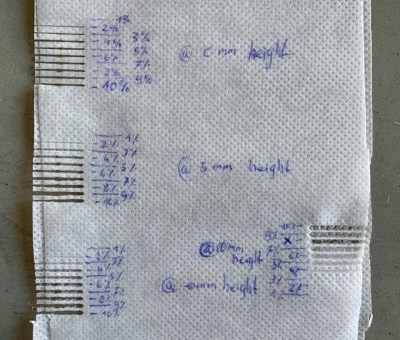Laser cutters are certainly a Hackerspace staple for cutting fabrics in some circles. But for the few fabrics derived from non-woven plastics, why not try fusing them together? That’s exactly what [Dries] did, and with some calibration, the result is a speedy means of seaming together two fabrics–no needles necessary!
The materials used here are non-woven goods often used in disposable PPE like face masks, disposable aprons, and shoe coverings. The common tool used to fuse non-woven fabrics at the seams is an ultrasonic welder. This is not as common in the hackerspace tool room, but laser cutters may be a suitable stand-in.
Getting the machine into a production mode of simply cranking out clothes took some work. Through numerous sample runs, [Dries] found that defocusing the laser to a spot size of 1.5mm at low power settings makes for a perfect threadless seam. The resulting test pockets are quite capable of taking a bit of hand abuse before tearing. Best of all, the fused fabrics can simply be cut out with another pass of the laser cutter. For fixtures, [Dries] started with small tests by stretching the two fabrics tightly over each other but suggests fixtures that can be pressed for larger patterns.
It’s great to see laser-cutters doubled-up as both the “glue” and “scissors” in a textile project. Once we get a handle on lasering our own set of scrubs, why not add some inflatables into the mix?

















Nice, now I want to screw around with parafoils made that way. I wonder if it can also be adapted to weld tyvek or polytarp.
This is great!
It seems like holding the fabrics in close proximity to one another would be one of the most important predictors of reliably getting good fusion. Perhaps making a bed-referenced presser from 1/4″ MDF sheet (or whatever fits under the laser head) would be good to weigh down and keep fabric from billowing where fusion passes will be placed. Slots could be cut in the bed-referenced board where the fusion passes would occur, and then could be removed for cutting. It might be that if the layers are held in close proximity the need for defocusing the laser might be lessened.
I am about to do a run of N95 mask covers out of non-woven polyethylene fabric, this will be very handy in some way, though these are only to be single layer coverings. Maybe this could even work for the center seam instead of stitching? That would be awesome….
a kind of heated ball pen would apply pressure while rolling and welding on its way.
Maybe something like a soldering iron with a small wheel on the end, I like this…
Need something like a sapphire ball lens, 5mm ish, with a weaker converging lens a couple of cm from it, with a BRD laser in the barrel of the pen, so the spot comes to focus just outside the ball. Might be good with high power IR since it would diverge the beam wide within a few inches of the ball, so in theory should be eye safe, unless you tried to weld your false eyelashes on with it or other stupidity.
Why not an air hockey table in reverse? Use an optically transparent (with respect to the laser) material for the surface with numerous holes in it instead of wood to reduce any effects of the beam on the surface. This should keep consistent pressure throughout stack of fabrics…Just a thought.
I like it, Might work in mine but w table would be a chore to set up. it would certainly hold the first layer down but you would have to be drawing a pretty high volume to pull down a second if the table was bigger than a K40. A machine dedicated to full-time production would certainly warrant it.
Many laser cutters have air assist that blows air on the cut to help clear the vaporized plastic. Perhaps just turning it on will press the fabrics together enough.
Perhaps, but as is my air assist has far too low a volume to do that. Easier to make happen than a vacuum table though!
I guess you could give it a trailing caster, like the nosewheel on a plane, that could press things down with a bit of spring tension, and the laser would shoot between the wheels.
One thing I’ve used is a vacuum food sealer’s heating element to attach them together. Works really well, just a bit limiting in the size of the line you can make. But the connection is super strong.
We’ve been doing a similar project at the University of Queensland bonding materials to scaffolds to make COVID-19 face filters. It’s promising
If you forget the flat bed and instead make an enormous rotary-axis drum, you can simply stretch the materials taut around the drum to keep them against each other. Would be a lot of work…
Nothing new… Know Companys that use this for like 2 decades.
dude, it’s hackaday, the only thing new here is that it is happening in my living room.